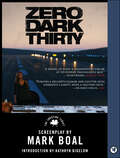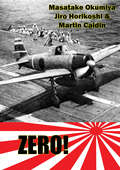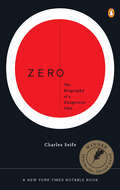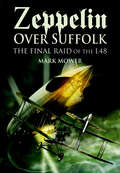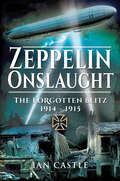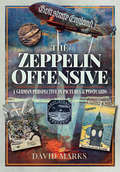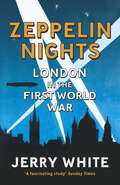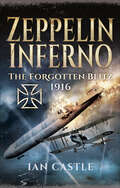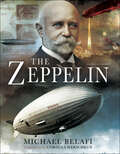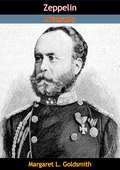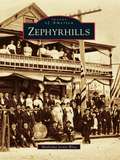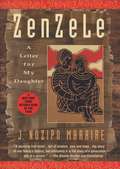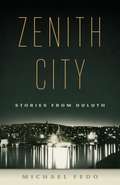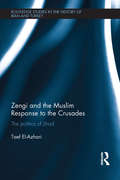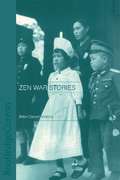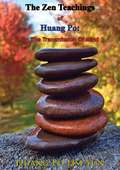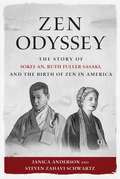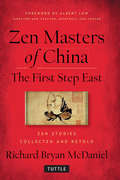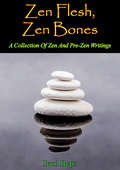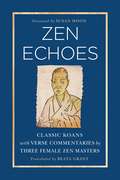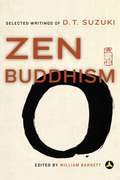- Table View
- List View
Zero Dark Thirty: The Shooting Script (Shooting Script Ser.)
by Mark BoalThe hunt for Osama bin Laden preoccupied the world and two American presidential administrations for more than a decade. But in the end, it took a small, dedicated team of CIA operatives to track him down. Every aspect of their mission was shrouded in secrecy. Though some of the details have since been made public, many of the most significant parts of the intelligence operation—including the central role played by that team—are brought to the screen for the first time in a nuanced and gripping new film by the Oscar®-winning creative duo of Kathryn Bigelow and Mark Boal, starring Jessica Chastain, Jason Clarke, Joel Edgerton, Jennifer Ehle, Mark Strong, Kyle Chandler, and Edgar Ramirez.The Newmarket Shooting Script Book includes: Introduction by Kathryn Bigelow Complete shooting script Q&A with Mark Boal by Rob Feld Production notes Storyboards Complete cast and crew credits
Zero!
by Martin Caiden Masatake Okumiya Jiro Hirokoshi"This is the thrilling saga of war in the air in the Pacific Theater of Operations during World War II told from the Japanese point of view. It is the story of the men who created, led, and fought in the deadly Zero fighter plane. In their own words, Jiro Horikoshi (who designed the Zero), Masatake Okumiya (leader of many Zero squadrons), and Saburo Sakai (Japan's leading surviving fighter ace) as well as many other men, tell the inside story of developing the Zero and Japan's air force. They tell what it felt like to bomb American ships and to shoot down American airplanes - and then of their shock when the myth of invincibility was shattered by the new Lightning, Hellcat, and Corsair fighters. They tell of the fight against the growing strength of a remorseless American enemy; and how, in desperation the Japanese High Command ordered the creation of deadly suicide squadrons, the Kamikaze. And finally they reveal their reaction to the dropping of the atomic bombs on Hiroshima and Nagasaki."-Print ed.
Zero: The Biography of a Dangerous Idea
by Charles SeifeThe Babylonians invented it, the Greeks banned it, the Hindus worshiped it, and the Church used it to fend off heretics. Now it threatens the foundations of modern physics. For centuries the power of zero savored of the demonic; once harnessed, it became the most important tool in mathematics. For zero, infinity's twin, is not like other numbers. It is both nothing and everything. In Zero, Science Journalist Charles Seife follows this innocent-looking number from its birth as an Eastern philosophical concept to its struggle for acceptance in Europe, its rise and transcendence in the West, and its ever-present threat to modern physics. Here are the legendary thinkers—from Pythagoras to Newton to Heisenberg, from the Kabalists to today's astrophysicists—who have tried to understand it and whose clashes shook the foundations of philosophy, science, mathematics, and religion. Zero has pitted East against West and faith against reason, and its intransigence persists in the dark core of a black hole and the brilliant flash of the Big Bang. Today, zero lies at the heart of one of the biggest scientific controversies of all time: the quest for a theory of everything. .
Zerborstene Texte und Wirklichkeiten in der Schwebe: Experimentelles Erzählen über den Nationalsozialismus (1990–2010) (Kontemporär. Schriften zur deutschsprachigen Gegenwartsliteratur #13)
by Daniela HenkeExperimentelle Texte über Holocaust und Nationalsozialismus fallen durch ein Forschungsraster. Durch ihre sperrige Form entziehen sie sich den Kategorien der memory studies – wegen ihrer brisanten Thematik sind sie ungeeignet für das rein formale Erkenntnisinteresse der klassischen Narratologie. Getragen von der Idee, dass Erzählformen selbst erzählen, verfolgt diese Untersuchung zwei Ziele. Zunächst wird eine allgemeine Typologie experimentellen Erzählens entworfen. Darauf folgen Analysen von Erzähltexten der Gegenwartsliteratur: Heldenfriedhof von Thomas Harlan, Morbus Kitahara von Christoph Ransmayr, Nahe Jedenew von Kevin Vennemann, Harlem Holocaust von Maxim Biller und Frühling von Thomas Lehr. Im Mittelpunkt stehen dabei die Funktionen experimentellen Erzählens mit Blick auf den ‚Undarstellbarkeitstopos‘ in seinen verschiedenen Variationen.
Zeppelin over Suffolk: The Final Raid of the L48
by Mark MowerThe dramatic story of the final mission and moments of the German Navy&’s prized airship during World War I. Zeppelin Over Suffolk tells the remarkable story of the destruction of a German airship over East Anglia in 1917. The drama is set against the backdrop of Germany&’s aerial bombing campaign on Britain in the First World War, using a terrifying new weapon, the Zeppelin. The course of the raid on that summer night is reconstructed in vivid detail, moment by moment—the Zeppelin&’s take off from northern Germany, its slow journey across the North Sea, the bombing run along the East Anglian coast, the pursuit by British fighters high over Suffolk, and the airship&’s final moments as it fell to earth in flames near the village of Theberton in the early morning of 17 June 1917. Mark Mower gives a gripping account of a pivotal episode in the pioneering days of the air war over England.
Zeppelin Onslaught: The Forgotten Blitz, 1914–1915
by Ian CastleAt the outbreak of the First World War, the United Kingdom had no aerial defense capability worthy of the name. Britain had just thirty guns to defend the entire country, with all but five of these considered of dubious value. So when raiding German aircraft finally appeared over Britain the response was negligible and ineffective. Of Britains fledgling air forces, the Royal Flying Corps had accompanied the British Expeditionary Force into Europe leaving the Royal Naval Air Service to defend the country as best it could. That task was not an easy one.From the first raid in December 1914, aerial attacks gradually increased through 1915, culminating in highly damaging assaults on London in September and October. London, however, was not the only recipient of German bombs, with counties from Northumberland to Kent also experiencing the indiscriminate death and destruction found in this new theater of war the Home Front. And when the previously unimagined horror of bombs falling from the sky began, the British population was initially left exposed and largely undefended as civilians were killed in the streets or lying asleep in their beds. The face of war had changed forever and those raids on London in the autumn of 1915 finally forced the government to pursue a more effective defense against air attack.This German air campaign against the United Kingdom was the first sustained strategic aerial bombing campaign in history. Yet it has become the forgotten Blitz.In Zeppelin Onslaught Ian Castle tells the complete story of the 1915 raids in unprecedented detail in what is the first in a planned series of three books that will eventually provide a complete history of Britains Forgotten Blitz of 1914–18.
The Zeppelin Offensive: A German Perspective in Pictures and Postcards
by David MarksAirship propaganda that&’s &“a visual treat . . . it will appeal to all those interested in how artwork was harnessed to convey information in time of war&” (Firetrench). Books on the Zeppelin raids during the First World War have, traditionally, focused on the direct impact of Britain, from the devastating effects on undefended towns and cities, the psychological impact of this first weapon of total war to the technological and strategic advances that eventually defeated the &“Baby Killers.&” Now, drawing on the largest postcard collection of its kind and other period memorabilia, David Marks tells the story of the Zeppelin during the First World War from a viewpoint that has rarely been considered: Germany itself. From its maiden flight in July 1900, the Zeppelin evolved into a symbol of technology and national pride that, once war was declared, was at the forefront of German&’s propaganda campaign. The Zeppelin links the rampant xenophobia at the outbreak of the conflict against England (it almost never was called Britain), France, Russia and their allies to the political doctrines of the day. The postcards that profusely illustrate this book show the wide-ranging types of propaganda from strident Teutonic imagery, myths and legends, biting satire and a surprising amount of humor. This book is a unique contribution to our understanding of the place of the Zeppelin in Germany&’s culture and society during the First World War. &“Well-recommended for its unique visual and psychological insights.&” —Over the Front &“Perfectly conveys the early optimism of the Zeppelin as both a symbol of national prestige and the weapon which would win the War.&” —Donna&’s Book Blog
Zeppelin Nights: London in the First World War
by Jerry White‘Zeppelin Nights is social history at its best… White creates a vivid picture of a city changed forever by war’ The Times2018 marks the centenary of the end of the First World War. In those four decisive years, London was irrevocably changed. Soldiers passed through the capital on their way to the front and wounded men were brought back to be treated in London’s hospitals. At night, London plunged into darkness for fear of Zeppelins that raided the city. Meanwhile, women escaped the drudgery of domestic service to work as munitionettes. Full employment put money into the pockets of the poor for the first time. Self-appointed moral guardians seize the chance to clamp down on drink, frivolous entertainment and licentious behaviour. Even against a war-torn landscape, Londoners were determined to get on with their lives, firmly resolved not to let Germans or puritans spoil their enjoyment. Peopled with patriots and pacifists, clergymen and thieves, bluestockings and prostitutes, Jerry White’s magnificent panorama reveals a battle-scarred yet dynamic, flourishing city.‘Jerry White's name on a title page is a guarantee of a lively, compassionate book full of striking incidents and memorable images… This is a fast-paced social history that never stumbles… A well-orchestrated polyphony of voices that brings history alive’ Guardian
Zeppelin Inferno: The Forgotten Blitz, 1916
by Ian CastleAt the beginning of 1916, as the world entered the second full year of global conflict, the cities, towns and villages of Britain continued to lay vulnerable to aerial bombardment. Throughout that period German Zeppelin airships and seaplanes had come and gone at will, their most testing opposition provided by the British weather as the country’s embryonic defences struggled to come to terms with this first ever assault from the air. Britain’s civilians were now standing on the frontline — the Home Front — like the soldiers who had marched off to war. But early in 1916 responsibility for Britain’s aerial defence passed from the Admiralty to the War Office and, as German air attacks intensified, new ideas and plans made dramatic improvements to Britain’s aerial defence capability. While this new system could give early warning of approaching raiders, there was a lack of effective weaponry with which to engage them when they arrived. Behind the scenes, however, three individuals, each working independently, were striving for a solution. The results of their work were spectacular; it lifted the mood of the nation and dramatically changed the way this campaign was fought over Britain. The German air campaign against Britain in the First World War was the first sustained strategic aerial bombing campaign in history. Despite this, it has become forgotten against the enormity of the Blitz of the Second World War, although for those caught up in the tragedy of these raids, the impact was every bit as devastating. In Zeppelin Inferno Ian Castle tells the full story of the 1916 raids in unprecedented detail in what is the second book in a trilogy that will reveal the complete story of Britain’s ‘Forgotten Blitz’.
The Zeppelin
by Michael BelafiThis new publication from Michael Belafi offers some truly intriguing content. Photographs of the mighty Zeppelin at all stages of development feature in a publication that aims to chart the entire course of the airship's history. Named after the German Count Ferdinand Von Zeppelin, an early pioneer of rigid airship development, the Zeppelin was first flown commercially by Deutsch Luftschiffahrts (DELAG), the world's first airline in revenue service. By mid–1914, DELAG had carried over 10,000 fare-paying passengers on over 1500 flights. When war hit, it was employed to military advantage, wreaking carnage upon Britain's towns and cities. German defeat in 1918 temporarily halted the airship business (many had to be surrendered under the terms of the Treaty of Versailles), although it did bounce back with the construction of the Graf Zeppelin in the 30s. A series of terrible accidents was soon to signal the demise of the Zeppelin however; following the Hindenburg disaster of 1937, and in the midst of a host of political and economic issues, the Zeppelin was soon to be consigned to the history books as one of the great aviation relics of the 20th Century. This new publication explores each facet of its history, and concludes by assessing the legacy of rigid airship development, still felt to this day.
Zeppelin: A Biography
by Margaret L. GoldsmithIN his fiery, adventurous youth he joined the Union Army in our Civil War, and became vitally interested in aeronauticsAS a man he was known as the most fearless and audacious officer the Württemberg ArmyAT fifty-two he retired and began the great adventure of his life—the conquest of the airTHEN, with magnificent courage, he rode over obstacle and failure to an achievement immortal in the history of flyingOriginally published in 1931, this is a biography of Count von Zeppelin, the German general turned aircraft manufacturer who founded the Zeppelin airship company.Ferdinand Adolf Heinrich August Graf von Zeppelin (8 July 1838 - 8 March 1917), the scion of a noble family, was born in Konstanz, Grand Duchy of Baden (now part of Baden-Württemberg) in Germany. His father was Württemberg Minister and Hofmarschall Friedrich Jerôme Wilhelm Karl Graf von Zeppelin (1807-1886).Count Zeppelin’s military career spanned more than three decades, beginning as an army officer in the army of Württemberg in 1855, seeing active service in the Franco-Prussian War of 1870-1871, and rising through the ranks to commander of the 19th Uhlans in Ulm and envoy of Württemberg in Berlin from 1882-1885. He retired from the army with the rank of Generalleutnant in 1891 at age 52. He was awarded the Ritterkreuz (Knight’s Cross) of the Order of Distinguished Service of Württemberg.His service as an official observer with the Union Army during the American Peninsular War led him to travel to St. Paul, Minnesota, where the German-born former Army balloonist John Steiner offered tethered flights; it was his first ascent in a balloon during this visit that is said to have been the inspiration of Count Zeppelin’s later interest in aeronautics.He passed away in 1917 at the age of 78, before the end of World War I. The unfinished World War II German aircraft carrier Graf Zeppelin and two rigid airships were named after him.
Zephyrhills
by Madonna Jervis WiseZephyrhills has had many monikers, including Oakdale, Abbott, Abbott Station, Friendly City, and City of Pure Water. The universal appeal of this treasured location is the weaving of diverse people. Native Americans first imprinted the area and are immortalized today at nearby Fort Foster and Fort Dade. In 1886, Simon J. Temple purchased land from the Florida Railway and Navigation Corporation. Soon after, Capt. H. B. Jeffries of the Pennsylvania 28th Calvary established a Civil War veterans' colony with son-in-law Raymond Moore. Jeffries coined the town's modern name during a multisensory excursion to the highest elevation point--scenic LeHeup Hill--where he gazed down on the city (no doubt taking in pastoral views and breathing fresh air from gentle breezes off the hills) and exclaimed, "a haven of 'zephyr' hills!"
Zenzele: A Letter For My Daughter
by J. Nozipo MaraireWritten as a letter from a Zimbabwean mother to her daughter, a student at Harvard, J. Nozipo Maraire evokes the moving story of a mother reaching out to her daughter to share the lessons life has taught her and bring the two closer than ever before. Interweaving history and memories, disappointments and dreams, Zenzele tells the tales of natives' struggle to turn Rhodesia into Zimbabwe's independence and the men and women who shaped it: Zenzele's father, an outspoken activist lawyer; her aunt, a schoolteacher by day and secret guerrilla fighter by night; and her cousin, a maid and a spy. Rich with insight, history, and philosophy, Zenzele is a powerful and compelling story that is both revolutionary and revelatory--the story of one life that poignantly speaks of all lives.
Zentralasien und die Seidenstraße: Wirtschaftlicher Aufschwung und Niedergang über mehrere Jahrtausende
by Stephan BarisitzDieses Buch bietet einen umfassenden Überblick über die vormoderne Wirtschaftsgeschichte Zentralasiens und der Seidenstraße, die mehrere Jahrtausende umfasst. Durch die Analyse einer Fülle von Quellen und Materialien veranschaulicht es die wiederholten wirtschaftlichen Blütezeiten der Seidenstraße, in denen sie über viele Jahrhunderte Orient und Okzident verband. Nomadische Steppenreiche beherrschten häufig Zentralasien, prägten dessen Wirtschaft und beeinflussten den Handel entlang der Seidenstraße. Das Buch untersucht die Ursachen und Auswirkungen des weitreichenden Booms des Überlandhandels und erörtert gleichzeitig verschiedene interne und externe Faktoren, die zum allmählichen wirtschaftlichen Niedergang Zentralasiens und letztlichzum Ende der Seidenstraße führten. Schließlich wird erläutert, wie der wirtschaftliche Niedergang zum chinesischen und russischen Kolonialismus im 18. und 19. Jahrhundert beitrug. Detaillierte Informationen, z.B. über den Verlauf der Seidenstraße in den verschiedenen Epochen, werden in Form zahlreicher neu erstellter Karten angeboten.
Zenith City
by Michael FedoDuluth may be the city of "untold delights" as lampooned in a Kentucky congressman's speech in 1871. Or it may be portrayed by a joke in Woody Allen's film Manhattan. Or then again, it may be the "Zenith City of the unsalted seas" celebrated by Dr. Thomas Preston Foster, founder of the city's first newspaper. But whatever else it may be, this city of granite hills, foghorns, and gritty history, the last stop on the shipping lanes of the Great Lakes, is undeniably a city with character--and characters. Duluth native Michael Fedo captures these characters through the happy-go-melancholy lens nurtured by the people and landscape of his youth. In Zenith City Fedo brings it back home. Framed by his reflections on Duluth's colorful--and occasionally very dark--history and its famous visitors, such as Sinclair Lewis, Joe DiMaggio, and Bob Dylan, his memories make the city as real as the boy next door but with a better story.Here, among the graceful, poignant, and often hilarious remembered moments--pranks played on a severe teacher, the family's unlikely mob connections, a rare childhood affliction--are the coordinates of Duluth's larger landscape: the diners and supper clubs, the baseball teams, radio days, and the smelt-fishing rites of spring. Woven through these tales of Duluth are Fedo's curious, instructive, and ultimately deeply moving stories about becoming a writer, from the guidance of an English teacher to the fourteen-year-old reporter's interview with Louis Armstrong to his absorption in the events that would culminate in his provocative and influential book The Lynchings in Duluth. These are the sorts of essays--personal, cultural, and historical, at once regional and far-reaching--that together create a picture of people in a place as rich in history and anecdote as Duluth and of the forces that forever bind them together.
The Zenith
by Duong Thu HuongFrom the most important Vietnamese author writing today, a powerful, ambitious novel about the thirst for absolute power Widely considered today's preeminent Vietnamese novelist, Duong Thu Huong has won acclaim for her exceptional lyricism and psychological acumen, as well as for her unflinching portraits of modern Vietnam and its culture and people. In her latest book, she offers a sweeping tale of thwarted love, political intrigue, and treachery that centers on the final months in the life of Ho Chi Minh at an isolated mountain compound where he is imprisoned both physically and emotionally. The Zenith reveals moral truths that continue to reverberate today among those many Americans who still silently live with sadness and regret over the Vietnam War.
Zengi and the Muslim Response to the Crusades: The politics of Jihad (Routledge Studies in the History of Iran and Turkey)
by Taef El-AzhariZengi gained his legacy as the precursor to Saladin. While Zengi captured Edessa, Saladin would capture Jerusalem, and both leaders fought to establish their own realms. However, Zengi cannot be fully understood without an examination of his other policies and warfare and an appreciation of his Turkmen background, all of which influenced his fight against the Crusades. Zengi and the Muslim Response to the Crusades: The politics of Jihad, provides a full and rich picture of Zengi’s career: his personality and motives; his power and ambition; his background and his foundation of a dynasty and its contribution, along with other dynasties, to a wider, deeper Turkification of the Middle East; his tools and methods; his vision, calamities and achievements; and how he was perceived by his contemporaries and modern scholars. Examining primary Muslim and non-Muslim sources, this book’s extensive translations of original source material provides new insight into the complexities of Zengi’s rule, and the politics of jihad that he led and orchestrated during the Crusades. Providing deeper understanding of Islamic history through a close examination of one of its key figures, this book will be a valuable resource for students and scholars interested in Muslim history and the Crusades in general.
Zen War Stories (Routledge Critical Studies in Buddhism)
by Brian VictoriaFollowing the critically acclaimed Zen at War (1997), Brian Victoria explores the intimate relationship between Japanese institutional Buddhism and militarism during the Second World War.Victoria reveals for the first time, through examination of the wartime writings of the Japanese military itself, that the Zen school's view of life and death was deliberately incorporated into the military's programme of 'spiritual education' in order to develop a fanatical military spirit in both soldiers and civilians. Furthermore, that D. T. Suzuki, the most famous exponent of Zen in the West, is shown to have been a wartime proponent of this Zen-inspired viewpoint which enabled Japanese soldiers to leave for the battlefield already resigned to death. Victoria takes us onto the naval battlefield in the company of warrior-monk and Rinzai Zen Master Nakajima Genjô. We view the war in China through the eyes of a Buddhist military chaplain. The book also examines the relationship to Buddhism of Japan's seven Class-A war criminals who were hung by the Tokyo War Crimes Tribunal in 1948.A highly controversial study, this book will be of interest, first and foremost, to students of Zen as well as all those studying the history of this period, not to mention anyone concerned with the perennial question of the 'proper' relationship between religion and the state.
The Zen Teachings of Huang Po: On The Transmission Of Mind
by John Blofeld P’ei Hsiu Huang Po His YunThis Historical text from the direct teaching of the Zen master, Huang Po, allows the Western reader to gain an understanding of Zen from the original source, one of the key works in its teachings; it also offers deepening and often startling insights into the rich treasures of Eastern thought.Huang Po, also known as Hsi Yun, is believed to have died as late as 850 A.D. He is regarded in a sense as the founder of the great Lin Chi sect. He lived below the Vulture Peak on Mount Huang Po, in the district of Kao An. Like most Zen masters, Huang Po taught in parables which were delivered as sermons, anecdotes, and dialogues. These have been collected here to present the teachings of the Master himself. He compares the mind to the sun travelling through the sky, sending forth light uncontaminated by the finest particle of dust. For those who have discovered the nature of Reality, he says, there is nothing old or new, concepts become meaningless and reason leads to error.Nowhere is the use of paradox in Zen illustrated better than in the teachings of Huang Po, who shows how the experience of intuitive knowledge which reveals to a man what he really is, cannot be communicated by words. With the help of these paradoxes, beautifully and simply presented in this collection, Huang Po could set his disciples on the right path. It is in this fashion that the Zen master leads his listener into the truth, often by a single phrase designed to destroy his particular demon of ignorance.Many of the dialogues recorded in The Zen Teaching of Huang Po took place in public assembly, generally with hundreds of the Master's followers in attendance. This text is remarkable for its purity of thought and speech. John Blofeld's translation reflects his deep understanding of Zen and gives it a crystal clear presentation. In addition, there are an introduction and explanatory notes that make this original and revered text even more valuable to the contemporary reader.
Zen Odyssey: The Story of Sokei-an, Ruth Fuller Sasaki, and the Birth of Zen in
by Janica Anderson Steven Schwartz Sean Murphy Joan WattsExplore two lives—and a relationship—that profoundly shaped American Zen.Ruth Fuller Sasaki and Sokei-an Shigetsu Sasaki: two pioneers of Zen in the West. Ruth was an American with a privileged life, even during the height of the Great Depression, before she went to Japan and met D. T. Suzuki. Sokei-an was one of the first Zen priests to come to America; he brought the gift of the Dharma to the United States but in 1942 was put in an internment camp. One made his way to the West and the other would find her way to the East, but together they created the First Zen Institute of America and helped birth a new generation of Zen practitioners: among them, Alan Watts, Gary Snyder, and Burton Watson. They were married less than a year before Sokei-an died, but Ruth would go on to helm trailblazing translations in his honor and to become the first foreigner to be the priest of a Rinzai Zen temple in Japan. With lyrical prose, authors Steven Schwartz and Janica Anderson bring Ruth and Sokei-an to life. Two dozen intimate photographs photos show us two people who aren’t mere historical figures, but flesh and blood people, walking their paths.
Zen Masters of China
by Albert Low Richard Bryan Mcdaniel[Zen Masters of China presents more than 300 traditional Zen stories and koans, far more than any other collection. Retelling them in their proper place in Zen's historical journey, it also tells a larger story: how, in taking the first step east from India to China, Buddhism began to be Zen.]The stories of Zen are unlike any other writing, religious or otherwise. Used for centuries by Zen teachers as aids to bring about or deepen the experience of awakening, they have a freshness that goes beyond religious practice and a mystery and authenticity that appeal to a wide range of readers.[Placed in chronological order, these stories tell the story of Zen itself, how it traveled from West to East but also how it was transformed in that journey, from an Indian practice to something different in China (Ch'an) and then more different still in Japan (Zen). The fact that its transmission was so human, from teacher to student in a long chain from West to East, meant that the cultures it passed through inevitably changed it.Zen Masters of China is first and foremost a collection of mind-bending Zen stories and their wisdom. More than that, without academic pretensions or baggage, it recounts the genealogy of Zen Buddhism in China and, through the stories themselves, illuminates how Zen became what it is today.]
Zen Masters of China: The First Step East
by Richard Bryan Mcdaniel Albert Low[Zen Masters of China presents more than 300 traditional Zen stories and koans, far more than any other collection. Retelling them in their proper place in Zen's historical journey, it also tells a larger story: how, in taking the first step east from India to China, Buddhism began to be Zen.]The stories of Zen are unlike any other writing, religious or otherwise. Used for centuries by Zen teachers as aids to bring about or deepen the experience of awakening, they have a freshness that goes beyond religious practice and a mystery and authenticity that appeal to a wide range of readers.[Placed in chronological order, these stories tell the story of Zen itself, how it traveled from West to East but also how it was transformed in that journey, from an Indian practice to something different in China (Ch'an) and then more different still in Japan (Zen). The fact that its transmission was so human, from teacher to student in a long chain from West to East, meant that the cultures it passed through inevitably changed it.Zen Masters of China is first and foremost a collection of mind-bending Zen stories and their wisdom. More than that, without academic pretensions or baggage, it recounts the genealogy of Zen Buddhism in China and, through the stories themselves, illuminates how Zen became what it is today.]
Zen Flesh, Zen Bones: A Collection Of Zen And Pre-Zen Writings
by Paul RepsWhen Zen Flesh, Zen Bones was published in 1957 it became an instant sensation with an entire generation of readers who were just beginning to experiment with Zen. Over the years it has inspired leading American Zen teachers, students, and practitioners. Its popularity is as strong today as ever.Zen Flesh, Zen Bones is a book that offers a collection of accessible, primary Zen sources so that readers can struggle over the meaning of Zen for themselves. It includes 101 Zen Stories, a collection of tales that recount actual experiences of Chinese and Japanese Zen teachers over a period of more than five centuries; The Gateless Gate, the famous thirteenth century collection of Zen koans; Ten Bulls, a twelfth century commentary on the stages of awareness leading to enlightenment; and Centering, a 4,000 year-old teaching from India that some consider to be the roots of Zen.--Print Ed.
Zen Echoes: Classic Koans with Verse Commentaries by Three Female Chan Masters
by Beata Grant Susan MoonThe voices of three female Zen masters reverberate in this much-needed collection.Too often the history of Zen seems to be written as an unbroken masculine line: male teacher to male student. In this timely volume, Beata Grant shows us that women masters do exist—and have always existed. Zen Echoes is a collection of classic koans from Zen’s Chinese history that were first collected and commented on by Miaozong, a twelfth-century nun so adept that her teacher, the legendary Dahui Zonggao, used to tell other students that perhaps if they practiced hard enough, they might be as realized as her. Nearly five hundred years later, the seventeenth-century nuns Baochi and Zukui added their own commentaries to the collection. The three voices—distinct yet harmonious—remind us that enlightenment is at once universal and individual. In her introduction to this shimmering translation, Professor Grant tells us that the verses composed by these women provide evidence that “in a religious milieu made up overwhelmingly of men, there were women who were just as dedicated to Chan practice, just as advanced in their spiritual realization, and just as gifted at using language to convey that which is beyond language.”
Zen Buddhism: Selected Writings of D. T. Suzuki
by William Barrett D. T. SuzukiNo other figure in history has played a bigger part in opening the West to Buddhism than the eminent Zen author, D. T. Suzuki, and in this reissue of his best work readers are given the very heart of Zen teaching. Zen Buddhism, which sold more than 125,000 as an Anchor paperback after its publication in 1956, includes a basic historical background as well as a thorough overview of the techniques for Zen practice. Concepts and terminology such as satori, zazen, and koans, as well as the various elements of this philosophy are all given clear explanations. But while Suzuki takes nothing for granted in the reader's understanding of the fundamentals, he does not give a merely rudimentary overview. Each of the essays included here, particularly those on the unconscious mind and the relation of Zen to Western philosophy, go far beyond other sources for their penetrating insights and timeless wisdom. What is most important about D. T. Suzuki's work, however--and what comes across so powerfully in these selections--is his unparalleled ability to communicate the experiential aspect of Zen. The intensity here with which Zen philosophy comes to life is without parallel in the canon of Buddhist literature. Suzuki stands apart from all teachers before or since because of his exceptional ability to eloquently capture in words the seemingly inexpressible essence of Zen.
